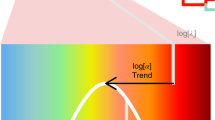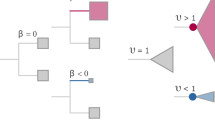Abstract
Ricklefs replies - Purvis1 states that, under random gradual change, clades accumulate variance in proportion to their total branch length. Accordingly, at a given age, clades with more species should exhibit greater variance. This is incorrect, as shown both analytically2,3 and by simulation4,5, and the error underlines a misunderstanding of my analysis.
Similar content being viewed by others
Main
Variance depends strictly on the average time of divergence between species within a clade and not on the number of species or total branch length. The positive relationship between species number and variance in Purvis's simulations with fixed time reflects the occurrence of earlier branch points in what turn out to be larger clades. Had Purvis simulated gradual evolution in an unconstrained speciation–extinction process with varied clade ages, he would have obtained a significant partial correlation between variance and time, which I was unable to detect in clades of passerine birds. The weaker time effect in Purvis's second simulation with constrained clade size reflects the distribution of most nodes in each tree at similar depth, regardless of the age of the root.
To determine whether time itself, and hence gradual evolution, contributes to trait variance, one must analyse data, whether observed or simulated, in which time and the number of species are allowed to vary independently. Purvis's simulations lack this independence: the first does not vary clade age; the second holds the species number constant. The results are not surprising, and they do not address the validity of my analysis. Although average divergence time and number of species are correlated among clades, multiple regression allows one to identify unique contributions of time and species number to trait variance among clades of different ages.
Purvis's comment about a type II error (failing to detect a true relationship) is of more concern, particularly because relative age, based on DNA-hybridization phylogeny6, is estimated less well than the number of species. In a test of the monophyly of 40 out of 106 (from ref. 6) tribe-to-family-level clades using a maximum-likelihood analysis of over 4 kilobases of the RAG-1 and RAG-2 genes7, only three were found that were significantly paraphyletic compared with 27 strongly supported and 10 ambiguous clades8. This does not “conflict markedly” with the monophyly of clades used in my analysis. It is of more importance, however, that the relative ages of clades in the sequence-based and DNA-hybridization phylogenies were not compared.
If the phylogeny in ref. 6 provides a reasonably accurate view of clade age, then the absence of a significant time effect on variance among different-aged clades would be sufficient to reject a model of gradual evolution that is independent of species number. Gradual evolutionary divergence, whether fast or slow, driven by interactions among species in a clade (as opposed to punctuated evolution associated with speciation9) is also species-dependent, rather than time-dependent, inasmuch as the pressure to diversify is in some way proportional to species number. Increasing knowledge of phylogenetic relationships makes this an opportune time to examine more closely the generation of trait variance in diversifying clades.
References
Purvis, A. Nature doi:10.1038/nature03092 (2004).
Slatkin, M. Paleobiology 7, 421–425 (1981).
Gavrilets, S. Proc. R. Soc. Lond. B 266, 817–824 (1999).
Raup, D. M. & Gould, S. J. Syst. Zool. 23, 305–322 (1974).
Valentine, J. W., Collins, A. G. & Meyer, C. P. Paleobiology 20, 131–142 (1994).
Sibley, C. G. & Ahlquist, J. E. Phylogeny and Classification of the Birds of the World (Yale Univ. Press, New Haven, Connecticut, 1990).
Sibley, C. G. & Monroe, B. L. Jr Distribution and Taxonomy of Birds of the World (Yale Univ. Press, New Haven, Connecticut, 1990).
Barker, F. K., Cibois, A., Schikler, P., Feinstein, J. & Cracraft, J. Proc. Natl Acad. Sci. USA 101, 11040–11045 (2004).
Gould, S. J. & Eldredge, N. Paleobiology 3, 115–151 (1977).
Author information
Authors and Affiliations
Corresponding author
Rights and permissions
About this article
Cite this article
Ricklefs, R. How do characters evolve? (reply). Nature 432, 166 (2004). https://doi.org/10.1038/nature03093
Published:
Issue Date:
DOI: https://doi.org/10.1038/nature03093
Comments
By submitting a comment you agree to abide by our Terms and Community Guidelines. If you find something abusive or that does not comply with our terms or guidelines please flag it as inappropriate.



